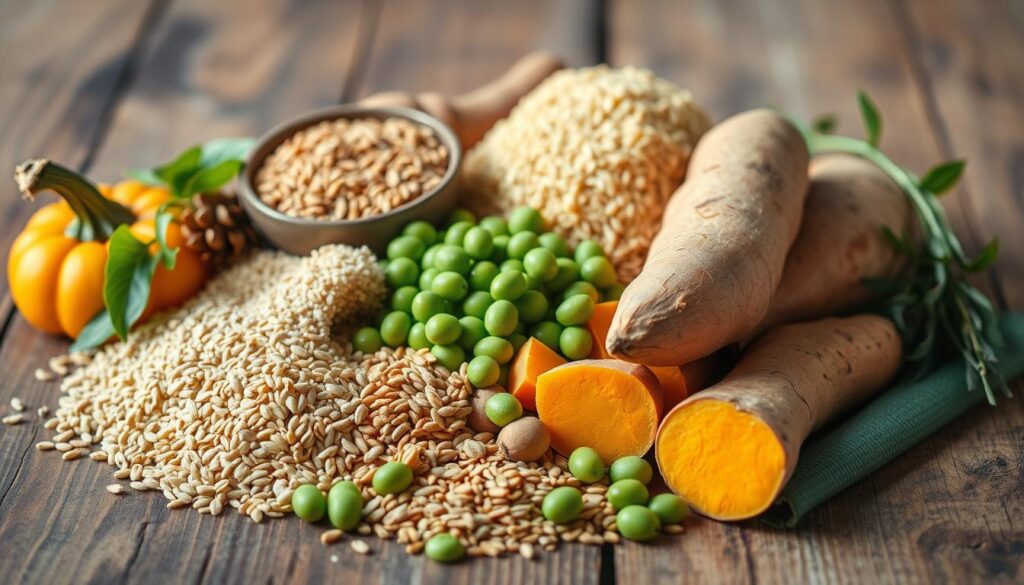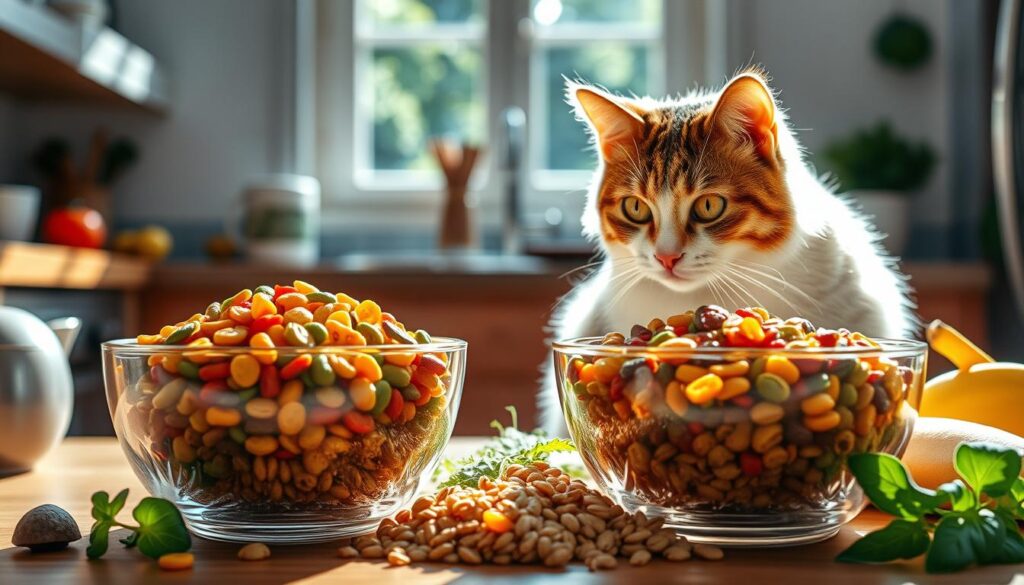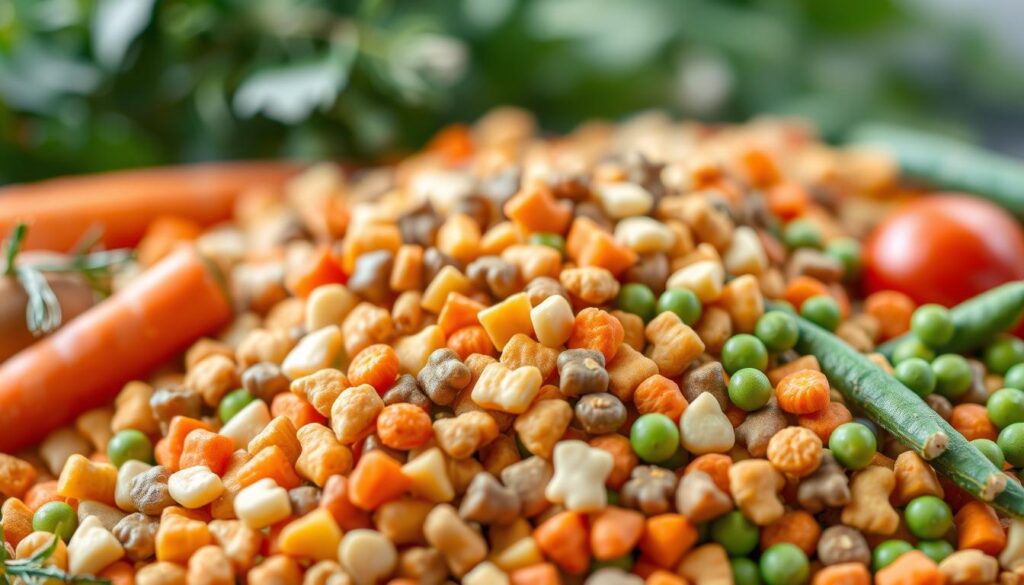Keeping your cat’s digestive system healthy is very important. High fiber cat food helps a lot. It’s good for sensitive stomachs, food allergies, and bowel issues.
It helps your cat’s digestive system work better. It also makes their stool better and helps with weight control.
Brands like Purina Pro Plan, Blue Buffalo, and Hill’s Science Diet make special high fiber cat food. These foods have the right amount of fiber and other important nutrients. They help your cat’s digestion and keep their gut healthy.
Key Takeaways
- High fiber cat food is essential for maintaining digestive health in felines.
- It can help manage sensitive stomachs, food allergies, and intestinal problems.
- Top brands offer specialized high fiber formulas to support your cat’s unique needs.
- Proper fiber content in cat food can also aid in weight management and stool quality.
- Consulting your veterinarian is crucial when transitioning your cat to a high fiber diet.
Understanding Digestive Health in Cats
Keeping your cat’s digestive system healthy is key. Cats can face digestive problems like vomiting, diarrhea, and constipation. Knowing about fiber benefits for cats and when they need more can help.
Common Digestive Issues in Cats
Cats can have many digestive problems. These include:
- Vomiting: This can be due to hairballs, food allergies, or health issues.
- Diarrhea: Changes in diet, infections, or stress can cause loose stools.
- Constipation: Not enough fiber, dehydration, or blockages can make it hard to pass stool.
Role of Fiber in Cat’s Digestive System
Fiber is very important for a cat’s digestive health. It helps make stool regular and absorbs water, making stools firmer. It also helps good bacteria grow in the gut, which is vital for digestion.
Signs Your Cat Needs More Fiber
If your cat shows these signs, they might need more fiber:
- Frequent hairballs
- Stool that’s not consistent
- Hard time staying at a healthy weight
Adding high-fiber cat food to their diet can help. It can improve their digestive health and overall well-being.
Benefits of High Fiber Cat Food for Indoor Cats
Indoor cats have special diet needs. High-fiber cat food helps meet these needs. It makes your cat’s life better in many ways.
High-fiber cat food helps with weight management. It makes your cat feel full longer. This helps keep their weight healthy.
It also helps with hairball control. Fiber helps hair pass through your cat’s body. This stops hairballs and keeps your cat comfy.
High-fiber food is good for many digestive tract conditions. It helps with IBD, colitis, constipation, and diarrhea. It also helps with diabetes and other chronic conditions.
When changing your cat’s food, do it slowly. Take 7-10 days to avoid upset stomach. Keep feeding times regular and control portions. This helps your cat’s digestion and energy.
| Fiber Content | Benefits |
|---|---|
| Around 12% fiber | Aids in weight management and improves satiety |
| Soluble and insoluble fiber blend | Helps regulate digestion and control hairballs |
| High protein, low carbohydrate | Supports lean muscle mass and metabolic health |
High-fiber cat food meets your indoor cat’s needs. It keeps them healthy and happy. With the right food, your cat can live a long, healthy life.
How Fiber Content Affects Weight Management and Hairball Control
Fiber in your cat’s food is very important. It helps with weight and hairballs.
Weight Control Benefits
Foods high in fiber are great for weight. Soluble fiber makes your cat feel full longer. It also helps them absorb nutrients better.
Insoluble fiber makes stool bigger and more frequent. This helps with weight control too.
Research says 6% fiber in cat food is good for weight. Foods with about 12% fiber are even better for cat obesity prevention.
Hairball Prevention Mechanisms
Fiber helps with hairball reduction. It binds with hair, making it easier to pass through the digestive system. This prevents hairballs.
Products for constipation and hairballs have 6.5% to 11% fiber. Brands like Hill’s® Prescription Diet Metabolic Crunchy Cat Treats and Vetnique® Labs Glandex Probiotic Fiber Supplement are good options.
Optimal Fiber Percentages
The right amount of fiber for your cat depends on their needs. Most adult cats need 3-5% fiber. Always check with your vet for the best amount.
When changing your cat’s diet to more fiber, do it slowly. This lets their body adjust. The right fiber helps your cat stay healthy and avoid hairballs.
Top Rated High Fiber Cat Food Brands
High fiber cat food brands help keep your cat’s digestive system healthy. Brands like Purina One Plus Indoor Advantage, Iams Proactive Health, and Hill’s Science Diet are top choices. They offer high fiber cat food options for different needs.
Purina One Plus Indoor Advantage has 2% fiber. Iams Proactive Health and Iams Proactive Health Indoor Weight Control have 3% fiber. Hill’s Science Diet Kitten Food has 5% fiber. Royal Canin Veterinary Diet Adult Gastrointestinal Fiber Response Dry Cat Food has 7% fiber.
For cats with sensitive stomachs, Wellness Core Grain-Free Original and American Journey Indoor Cat Food are good choices. They have 3% and 6% fiber, respectively. Always talk to your vet to find the best fiber content for your cat.
These high fiber cat food brands help with digestion, weight management, and preventing hairballs. They keep your cat happy and healthy.
Wet vs. Dry High Fiber Cat Food Options
Pet owners can choose between wet and dry high fiber cat food. Both types have benefits for cats.
Benefits of Wet Food
Wet cat food is easy to digest and keeps cats hydrated. It has fewer calories and carbs than dry food. This helps with weight control.
Wet food also helps prevent urinary tract problems and keeps kidneys healthy.
Advantages of Dry Food
Dry cat food is great for dental health because it’s crunchy. It’s also easy to leave out for cats to eat whenever they want. Plus, it’s cheaper and more convenient.
Some cats love the taste and texture of dry food. This makes it a favorite among many cats.
Making the Right Choice
Choosing between wet and dry food depends on your cat’s needs. Think about your cat’s age, health, and eating habits. A mix of both can also be good.
| Wet Cat Food | Dry Cat Food |
|---|---|
| Generally easier to digest and provides additional hydration | Can be left out for free-feeding and may help with dental health |
| Often contains fewer calories and carbohydrates | Typically more convenient and cost-effective for pet owners |
| Moisture content can help prevent urinary tract issues and support kidney health | Some cats prefer the taste and texture of dry food |
Choosing between wet and dry cat food depends on your cat’s needs. Think about what’s best for their health and taste. This way, your cat gets the best nutrition.
Natural Sources of Fiber in Cat Food
Natural fiber sources in cat food are very important. They help with digestion, weight, and prevent hairballs. Look for cat foods with pumpkin, beet pulp, and fruits and vegetables.
Pumpkin is great for blood sugar and healthy stools. Beet pulp helps with weight and digestion. Cellulose and wheat bran make stools bulkier and reduce discomfort.
Ground flaxseed is also good. It has both soluble and insoluble fibers. This makes digestion better and gives a shiny coat.
Choose a cat food with 2% to 8% fiber. This helps avoid digestive problems. Slowly adding fiber helps your cat adjust and get the best benefits.

Talking to your vet is key when changing your cat’s diet. The right fiber sources keep your cat healthy and happy.
High Fiber Cat Food for Senior Cats
As cats get older, they need different food. Senior cats, 10 years and up, need more fiber. This helps their digestive system. Brands like Hill’s Science Diet and Royal Canin make special food for them.
Age-Specific Nutritional Needs
Senior cats often have health problems. They drink more water and pee more. This is because of dehydration.
Wet food is better for them. It has lots of moisture, like their natural diet.
Also, over 90% of cats over 12 have arthritis. Their food should help with joint health. It often has glucosamine and chondroitin for this.
Recommended Brands for Seniors
Here are some good high fiber foods for seniors:
- Hill’s Science Diet Mature Adult 7+ Chicken Recipe: It has the right amount of fiber. It also has L-carnitine for weight and antioxidants for the immune system.
- Royal Canin Aging 12+ Wet Cat Food: It’s made for older cats. It has nutrients for digestion and kidney health.
- Purina ONE Healthy Kitten Formula: It’s not just for kittens. It’s good for older cats too because of its balanced nutrition and fiber.
These foods are easy to digest. They also have supplements for joints and brain health. This makes them great for senior cats.
“As cats age, their nutritional needs change, and it’s important to provide them with a diet that supports their overall health and well-being.”
Grain-Free High Fiber Options
Looking for the best high fiber cat food? Cats with grain sensitivities or allergies might like grain-free options. These formulas use sweet potatoes or peas for fiber, avoiding grain irritants.
The Wellness Core Grain-Free Original Formula is a top pick. It has 3% fiber and is high in protein and low in carbs. This is good for indoor cats that don’t move much.
The American Journey Indoor Cat Food is another great choice. It has 6% fiber from beet pulp and pumpkin. It helps with hairballs and keeping your cat at a healthy weight.
But, talk to your vet before switching your cat’s food. Some studies link grain-free diets to heart problems in cats. Your vet can help keep your cat healthy.
Finding the right high fiber cat food depends on your cat’s needs. Work with your vet to pick the best food for your cat’s health and happiness.
Transitioning Your Cat to High Fiber Cat Food
Starting your cat on high-fiber food can be easy. Just do it slowly over 7-10 days. Mix a little new food with their old food at first. Then, slowly add more new food.
Step-by-Step Guide
- Start with 25% new food and 75% old food.
- Slowly add more new food, reaching 50% by day 5.
- By day 7-10, your cat will only eat the new food.
Common Adjustment Issues
You might see changes in your cat’s stool or eating habits. These are normal and will get better in a week or two. Your cat’s body will get used to the new food.
If your cat has ongoing problems like diarrhea or won’t eat the new food, see a vet. They can figure out why and help your cat adjust to the new cat food transition and dietary changes.

“A gradual transition to a high-fiber diet is key to ensuring your cat’s digestive health and acceptance of the new food.”
Special Dietary Considerations and Restrictions
High-fiber cat food is good for many cats. But, some cats need special diets because of health issues or allergies. Always talk to a vet before changing your cat’s food, especially if they’re sick.
Some cats need special food because of allergies or sensitivities. About 0.1 percent of cats and dogs have these issues. Most have skin problems, and some have tummy troubles. Finding out what they’re allergic to helps pick the right food.
Older cats need special food too. They get older and their needs change. A vet can help make sure they get the right food, including fiber, to stay healthy.
| Dietary Consideration | Potential Issues | Recommended Approach |
|---|---|---|
| Food Allergies/Sensitivities | Skin irritation, gastrointestinal distress | Eliminate suspected allergens through a food trial, consult veterinarian |
| Senior Cat Nutrition | Age-related changes in nutritional needs | Consult veterinary nutritionist, adjust fiber and other nutrient levels |
| Obesity and Weight Management | Diabetes, heart disease, joint stress | Incorporate high-fiber foods to promote satiety and healthy weight |
Working with your vet is key to your cat’s diet. They can help with allergies, senior care, or weight issues. Tailoring your cat’s diet keeps them healthy and happy.
Monitoring Your Cat’s Response to High Fiber Diet
Changing your cat’s food to high-fiber is key for their health. It’s important to watch how they do to make sure it’s working right.
Positive Signs to Look For
Look for these signs that your cat is doing well on high-fiber food:
- Improved stool consistency: Soluble fibers help with bowel movements and prevent constipation.
- Reduced hairball frequency: Insoluble fibers help move hair through the digestive tract, reducing hairballs.
- Maintained or improved weight: High-fiber diets can help with weight management by making them feel full.
- Increased energy levels and a healthy coat: A good high-fiber diet supports overall health and energy.
When to Consult a Vet
Even with benefits, watch your cat closely. If you see any problems, talk to your vet:
- Persistent digestive issues: Ongoing diarrhea, constipation, or discomfort may need vet help.
- Significant weight changes: Unexpected weight loss or gain could mean a diet or health issue.
- Any other concerning symptoms: Changes in energy, coat, or behavior may mean the diet isn’t right.
Watching your cat closely and acting fast can make the high-fiber diet work. If you’re unsure, always talk to your vet. They can help with cat health monitoring and diet effectiveness. Remember, your vet is there to help.
“Paying close attention to your cat’s response to a high-fiber diet can help ensure their digestive health and overall well-being.”
Conclusion
High fiber cat food can really help your cat’s health. It can improve their digestion, weight, and overall well-being. By picking the right food and slowly changing their diet, you can fix common health issues.
Choosing the right high fiber cat food benefits means knowing what your cat needs. This includes their age, how active they are, and any health problems. Always talk to your vet to make sure you’re feeding them the best food for their health.
By adding high fiber cat food to their diet, you help their digestion and weight. This also helps them stay healthy for a long time. Make sure to focus on your cat’s nutrition and work with your vet to find the best food for them.


A Life-Changing Experience with This Weight Loss Supplement (Nagano Tonic)
I’ve always struggled with finding a weight loss solution that actually works for me. Like many, I’ve tried numerous diets, exercise routines, and supplements over the years—some worked for a short time, but nothing ever gave me long-term results. That was until I decided to try the weight loss supplement I found : Link to the Supplement.
From the moment I started using it, I noticed a difference. Not only did I feel more energized, but my cravings also became more manageable. The best part? I started seeing results much quicker than I anticipated! Over the course of just a few weeks, I noticed a significant reduction in belly fat and overall weight loss that I hadn’t been able to achieve before.
What makes this supplement stand out from all the others I’ve tried is how it supports me in my daily routine without any jitters or energy crashes. I’m able to stay focused and motivated, which has made it easier to stay on track with my diet and exercise plan.
This product truly exceeded my expectations, and I feel more confident and healthier than ever before. If you’re struggling with your weight loss journey like I was, I highly recommend giving this supplement a try. It’s been a game-changer for me, and I’m sure it can work wonders for you too!
Contant Them on email .. tonicnagano50@gmail.com
I’ve tried so many weight loss products over the years, but nothing worked like this supplement! Since I started using it, I’ve noticed a big difference in my energy levels and appetite control. In just a few weeks, I’ve lost weight and feel so much better. It’s been easy to stick with, and the results speak for themselves. Highly recommend this to anyone looking to make a real change!
wasn’t sure what to expect, but this weight loss supplement has really impressed me! After just a few weeks of use, I’ve already dropped a few pounds and feel more motivated to stay active. It’s helped curb my cravings and boosted my energy throughout the day. I’m excited to keep going and see even better results. Definitely worth trying!
Reach them on tonicnagano50@gmail.com
I was skeptical at first, but this supplement has truly made a difference in my weight loss journey. I’ve lost weight without feeling deprived or sluggish. My cravings are under control, and I feel more confident in my body. It’s easy to incorporate into my daily routine, and the results speak for themselves. I’m so glad I gave it a try!
Thanks David, i do use the link to make my purchase. you can get too here http://surl.li/iasppy
I’ve tried so many weight loss products, but this one has been by far the most effective. In just a few weeks, I’ve noticed a visible difference in my body and energy levels. It’s helped me stay on track without the constant hunger pangs and cravings. I’m really happy with my progress and can’t wait to see where I’ll be in another month!
This Nagano Tonic has been amazing! In just a few weeks, I’ve lost weight, feel more energized, and my cravings are under control. Highly recommend it!
Thats the link to purchase http://surl.li/iasppy